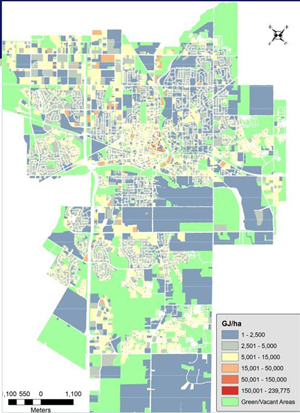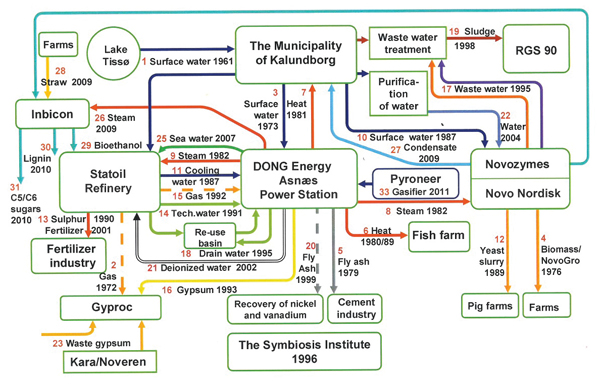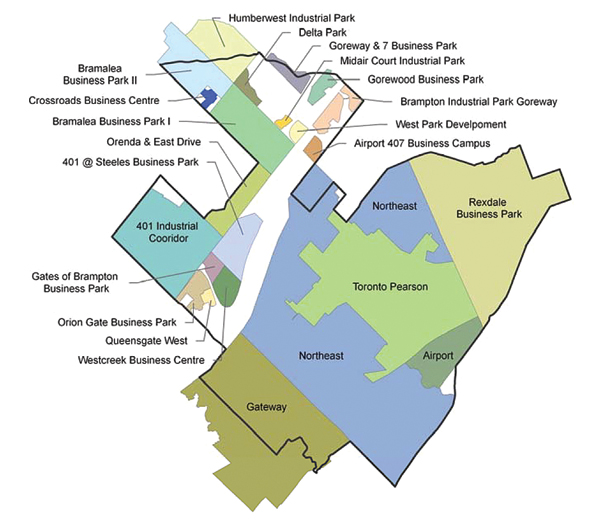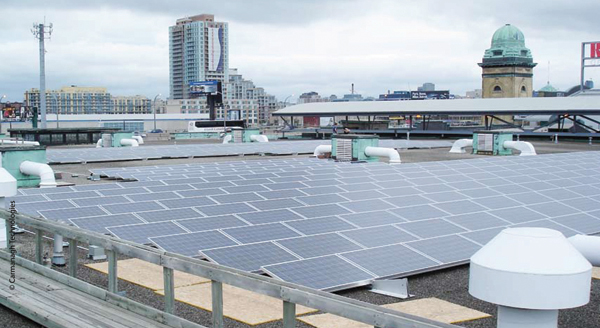by Stephen Kishewitsch
The time seems to be past when the only form of supply was a multi-hundred-megawatt station located safely away from everyone, feeding power into the built-up city through long transmission lines. Toronto is a good example in Canada of the densely-built core where new supply lines are a challenging matter, whether overhead or underground, let alone new generation – while new condos are going up everywhere (150 cranes at work around the city, hoisting steel and concrete high above the sidewalk, is one estimate, and each building adding about two MW of load). But even smaller cities are facing densification – Guelph has two major developments planned for the city’s downtown (see below). The key remains putting generation close to load, however they can. That’s the argument of experts like Ian Bush of Cogen Canada, an organization that has done a number of detailed case studies.
Cogeneration and district energy
True to his organization’s focus, Mr. Bush believes cogeneration – not facilities 100 MW and up, but large numbers of small ones, on the order of ten megawatts or smaller, scattered throughout the city where load is concentrated, is the answer. Let that grow to ten percent of supply and it will have reached a tipping point, he believes, and take off.
The City of Guelph, a one-hour drive northwest of Toronto, is a case in point. Two downtown developments are planned, worth $250 million and creating space for up to 1700 new residents. A 5.7 MW cogeneration facility is part of the plan for that part of the city. Several options are currently being held open for siting the generation: a couple of city-owned buildings are available to host the facility, and discussions are underway with the condo developers, explains Guelph’s Corporate Manager – Energy, Rob Kerr.

Guelph has plans, still in the preliminary stage for now, for two more CHP facilities, one centred on the university. Guelph’s plans (the Community Energy Plan is properly now the Community Energy Initiative, having moved from the planning to the implementation stage) for CHP totalling 28 megawatts, out of an overall total, including photovoltaics, of 60 MW. The city’s total average demand is about 230 MW.
East Gwillimbury also has a Community Energy Plan that calls for a distributed thermal network and potentially combined heat and power in order to provide a “future–proof” energy system that is not only resilient but competitive and more reliable. This is seen as not only as a benefit for economic development and investment but also necessary to meet the town’s greenhouse gas reduction targets. One of the primary objectives of the town is to establish an energy company that would act as the utility responsible for all manner of energy related activities including the development of the district system. The town’s Economic Development & Sustainability Manager Dan Stone says one of the biggest challenges is that the town has yet to experience its significant growth and new development areas are greenfield areas at relatively low density and energy intensity. “The town is in the process of exploring the opportunities for developing in integrated community energy system, which would be anchored by the thermal network we expect to be developed, financed and operated through some form of public-private partnership model,” he said.
Toronto’s city-owned Exhibition Place has an under-utilized 1.6 MW tri-generation system, but a planned hotel will improve the load match. The city is studying a number of candidates for local district energy systems, but details were not available for publication at press time. Another project involves building, for the moment, a heat-only facility using the large volumes of wood waste generated from the city’s maintenance of its urban forest. There are also plans, still under development, to generate biogas from the city’s green bin program, clean the gas to natural gas standards, inject it into Enbridge’s system – and then withdraw the equivalent at other points to power the city’s garbage trucks. System biogas, or renewable natural gas (RNG) is the term for the practice – it’s a form of wheeling, comparable to wheeling electricity, and Union Gas and Enbridge are currently seeking a ruling on it from the Ontario Energy Board. Guelph has similar plans, for 2 MW worth of biogas.
The ideal case is the eco-industrial park, built to attract investors and businesses with an integrated system of services. The much-cited paragon of eco-industrial parks is in the town of Kalundborg, Denmark, outfitted not merely with a district energy system to supply both heat and power, but designed so that its member industries supply each other, the waste product of one becoming the feedstock for another.

In Toronto, Pearson International Airport is to form the nucleus of the Pearson Eco-Industrial Zone, ultimately a creation of the Toronto Regional Conservation Authority (TRCA), through the agency set up for the purpose, Partners in Project Green. Here as elsewhere the basis of the zone will be a thermal grid, planned in its initial stage as a relatively modest system, around 20 MW in capacity, for the area around Dixon and Airport Road, and able to incorporate power generation as the economics permit. The option is open to use the airport’s existing cogeneration plant, and extend the heat supply to the new grid, or to build fresh. A feasibility study has been recently completed, but was not available at time of publication.

While the airport project is a built-up zone, Guelph is designing its own greenfield project, Hanlon Creek Business Park, covering 675 acres and intended to host 10,000 new jobs by 2031, a date set by the provincial Places to Grow Act of 2005. Once again, the basis for the zone is a thermal grid, but the electrical capacity is planned to be 10 – 12 MW.
Cogeneration is a subject dear to the hearts of APPrO and its members, as the ideally efficient pairing of heat, electricity and possibly cooling in a single package, but it continues to face practical obstacles. See “How much cogen?” this issue.
Solar power
Some five years ago, the 100 kW photovoltaic array on the roof of the Horse Palace, at the city-owned Canadian National Exhibition, was the largest in Canada.

The megawatt of new photovoltaic capacity being installed on the roofs of ten city-owned properties, roughly the same amount on each, will make it ordinary. Another megawatt of rooftop solar is planned, as the maintenance schedule for those properties dictates. Rob Maxwell, in Toronto’s Renewable Energy Office, estimates that potentially, at current FIT rates and under a reasonable business model, the city might be able to install three to four MW of photovoltaic power over next 5 years, under an assumption of the number of buildings being re-roofed in that time, that then become candidates. But here, too, the broader picture is involved. Before installing a 100-kW or more rooftop solar field, for example, the City may well need to consider shading issues from new high-rise construction that could happen over the next twenty years. The City is working closely with Toronto Hydro to facilitate electrical interconnections for these projects.
Guelph has a rooftop solar program as well, and a solar farm planned for a closed landfill. Another owner of a greenfield site plans to develop a solar farm rather than a residential subdivision. East Gwillimbury’s Community Energy Plan also calls for the development of photovoltaics, more than 300,000 kW worth.
And, of course, the revenue from PV under the FIT program has caused the accountants at City Hall to get their calculators out.
For more information on the FIT Two-Year Review, visit this link. For general information on the FIT program, visit this link. Those interested in developing a solar project should visit the Renewable Energy Facilitation Office’s website.
Storage support for hot spots
Constrained areas are a condition that has Toronto Hydro staff in particular working long hours, though they are hardly unique to Toronto. “In such areas electrical capacity is limited by incoming supply capacity or station bus capacity or physical space to route new feeders,” said Jack Simpson, Toronto Hydro’s Director of Capacity Planning. “Many urban stations are reaching 80 to 90% design capacity, and at times the local grid strains to keep up with demand.” Fortunately, Toronto Hydro and some innovative entrepreneurs have found some answers. Toronto Hydro is working with Ontario startup Hydrostor on a system that will place compressed air storage in the form of giant airbags on the bed of Lake Ontario, to serve as energy storage, directed in particular at supporting one of the city’s constrained-area “hot spots.” The air bags – oversize, thick-skinned balloons capable of holding, under present design, four hours worth of power supply – will have air pumped into them using off-peak power, and then release it when demand, and prices, are high. The system will have a delivery capacity of 1MW, and round-trip efficiency of over 70%. The system is scalable and offers a good fit for many large urban areas situated near lakes and oceans. Toronto Hydro’s preferred location is on one of the islands in Toronto Harbour, where a substation has some spare capacity, and the power will be used to support a constrained area downtown (Esplanade Station). (See “Compressed air storage,” this issue.)
Toronto Hydro is working with another startup company, Temporal Power, and its flywheel system, that will be used to provide another ancillary service, voltage support. The company says its low-friction design allows the flywheel to retain more than 90% of the energy put into it over 24 hours (see story page 31).
CDM
Rob Maxwell quietly boasts that new construction under Toronto’s Better Buildings Partnership Program was built to higher efficiency standards than the Ontario building code, up until that was amended and began applying to new construction in 2012. The city is now reviewing its own Toronto Green Standard and looking at ways to continue to ratchet the standard higher. It’s based on the LEED (Leadership in Energy and Environmental Design) standards, which allow a developer a menu of options from which to choose. Incorporating renewable energy is not at this point a requirement, but the city is considering it in order to demonstrate leadership, so that others may follow suit.
The city has met and exceeded the OPA’s requirement of 90 MW of CDM, using both retrofits and new construction, counting buildings in the MUSH sector and high-rise residential. On a per-square-foot basis energy demand is actually decreasing, though of course with all the new construction the total is rising.
Even here, Maxwell points out, it goes beyond just saving money to matters of economic development. “We’re keeping energy dollars in the city economy,” he says. “Recent figures say the city has sent over $2 billion out of the province for energy resources. We’re stimulating local industry and helping create hundreds if not thousands of jobs.”
For more information on CDM programs, visit the OPA’s Conservation page, http://www.powerauthority.on.ca/opa-conservation
Making distribution smarter also helps
The more a utility knows about the condition of its grid, the more it can squeeze out of what it has and the better the reliability it can provide. This returns us to a topic this magazine has touched on before, the smart grid. Every time Toronto Hydro replaces a piece of equipment that has reached its scheduled end of life, it adds new functionality for data acquisition, transmission, analysis and system control. As Barry Chuddy puts it, “The grid isn’t just wires and poles anymore. It can now tell you what’s happening, such as a power outage at 2 AM, and just where and what has been affected – a line or a transformer, say, before the consumers are aware of it. The utility also knows where its trucks are, and whether they’ve been dispatched.”
“Distribution utilities are at the forefront,” says Tom Rand at the MaRS Centre in Toronto, which assists companies with new ideas to bring them to market. “They [distribution utilities] will be inheriting the problems that were only dealt with on the transmission system. There’s a whole layer of data that needs to be generated.” He mentions synchrophasors, an installation typically costing tens of thousands of dollars, that expands a transmission grid’s ability to put more power on a given line – a service for which one of his clients is building a device that incorporates multiple functions for much less cost. Then, instead of a few hundred in all of North America, there will be hundreds of thousands at every demand or supply node on every distribution system, allowing, for example, small generators to get on where before they would have been excluded because of some condition that only occurs at certain points in the year. (See “Smarter distribution will allow for more DG,” this issue.
For more information on Ontario’s development of a smart grid, visit the IESO’s Smart Grid page.
See also the following related stories:
Paris supplied by energy from waste
Compressed air storage helps balance urban power
Smarter distribution will allow for more DG
